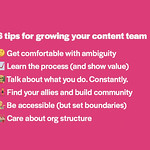From Solo to Scaled

Building a Sustainable Content Strategy Practice
Content strategy is clearly critical to your organization, but where do you start, and how do you grow it into a true practice? Whether you’re a lone content person tasked with creating a content strategy practice from scratch, or a leader struggling to scale one up, From Solo to Scaled is your blueprint for creating and managing a content strategy practice that is sustainable and successful.
Content strategy is clearly critical to your organization, but where do you start, and how do you grow it into a true practice? Whether you’re a lone content person tasked with creating a content strategy practice from scratch, or a leader struggling to scale one up, From Solo to Scaled is your blueprint for creating and managing a content strategy practice that is sustainable and successful.
Testimonials
This will be an instant classic among the content strategy core library. It builds on those books that have gone before it and leads the practitioner further on their journey. Hard to do, but Natalie managed it and made it look effortless (even though I know it was not).
Amy Mihlhauser, content strategist
This book is a fantastic guide for anyone who is trying to navigate through the fog of establishing and scaling a content strategy practice. I love how Natalie cuts through the chaos and ambiguity and offers practical, actionable advice and frameworks to follow. As I continue to scale up the practice at my company, this book will definitely be a valuable resource.
Andy Welfle, co-author of Writing Is Designing, Head of Content Design at Adobe
If you’re often the only ‘content person’ in the room, you’ll learn the frameworks you need to articulate content strategy—and your value—across your organization.
Justin McKinley, content director, Fortune 100s and startups
Wow, this is a comprehensive, relatable yet no-frills manual for success for content designers and strategists of any level. It’s really a cheat code.
Aladrian Goods, Content Design Manager, Intuit
I’ve had to build and scale a content strategy practice from scratch, and I can tell you that it would have been 100% easier if I’d had Dunbar’s book in my hands.
David Dylan Thomas, founder, CEO at David Dylan Thomas, LLC, author, Design for Cognitive Bias
Table of Contents
Foreword by Kristina Halvorson
Chapter 1: The Content Strategy Practice Blueprint
Chapter 2: Structural Alignment
Chapter 3: Building Materials
Chapter 4: Expansion: Building Up or Building Out
Chapter 5: Measuring Success
Chapter 6: Maintaining a Strong Core
Chapter 7: Retooling
Chapter 8: Scaffolding for Sustainable Growth
Chapter 9: Inspection-Ready: Engaging the Executive Suite
Chapter 10: The Final Walkthrough
FAQ
These common questions and their short answers are taken from Natalie Dunbar’s book From Solo to Scaled: Building a Sustainable Content Strategy Practice. You can find longer answers to each in your copy of the book, either printed or digital version.
- What do you mean by “From Solo to Scaled?”
This book is meant to help you build or augment content strategy practices of various sizes. You’ll benefit from the approaches in this book if you’re the lone content person in your business (a solo practitioner), or the manager of a small to medium-sized content team looking to grow or scale your operations to meet an increase in demand. Chapters 1 through 5 teach you the steps for building practices of any size. You’ll learn how to maintain the core of your practice in Chapter 6 (also appropriate for practices of varying sizes). Subsequent chapters (Chapter 6–9) focus on sustainability and scaling for when you know you’re ready to grow.
Sample Chapter
This is a sample chapter from Natalie Marie Dunbar’s book From Solo to Scaled Building a Sustainable Content Strategy Practice. 2022, Rosenfeld Media.
Chapter 1: The Content Strategy Blueprint
I’m fascinated by buildings: single family structures, high-rise dwellings, and especially office towers. As such, I’ve always had a healthy curiosity about the construction process. For example, Figure 1.1 shows a Habitat for Humanity building that I worked on. From the initial breaking of ground to the completion of a building’s façade, I find comfort in both the art and order of construction—how foundations support columns, columns support beams, and beams support floors. When the building plans are followed as written, every element comes together perfectly to create a strong structure that is capable of withstanding natural elements like wind and earthquakes.














